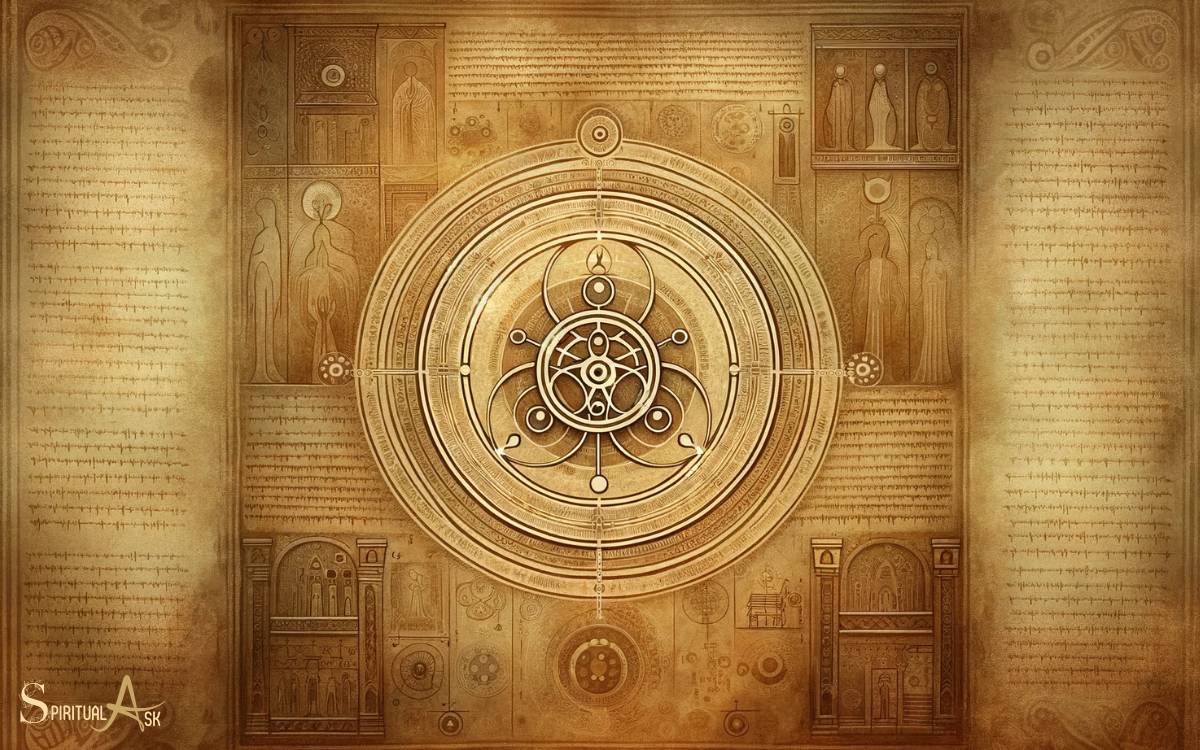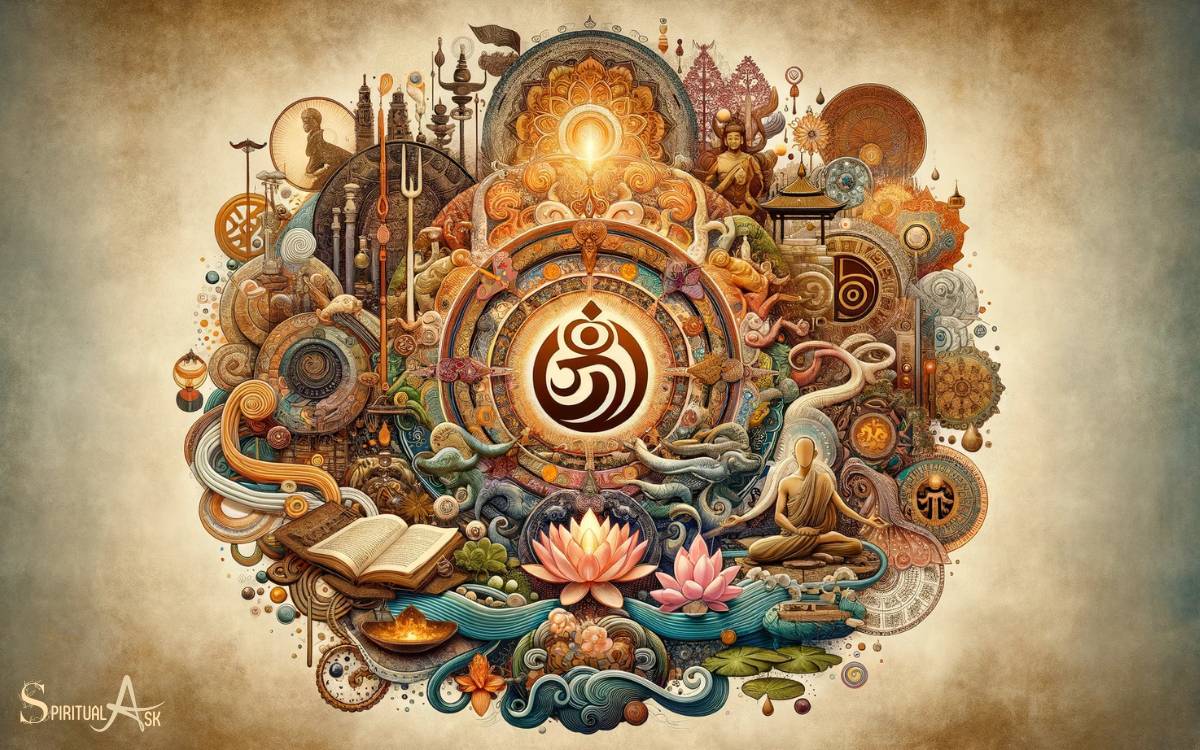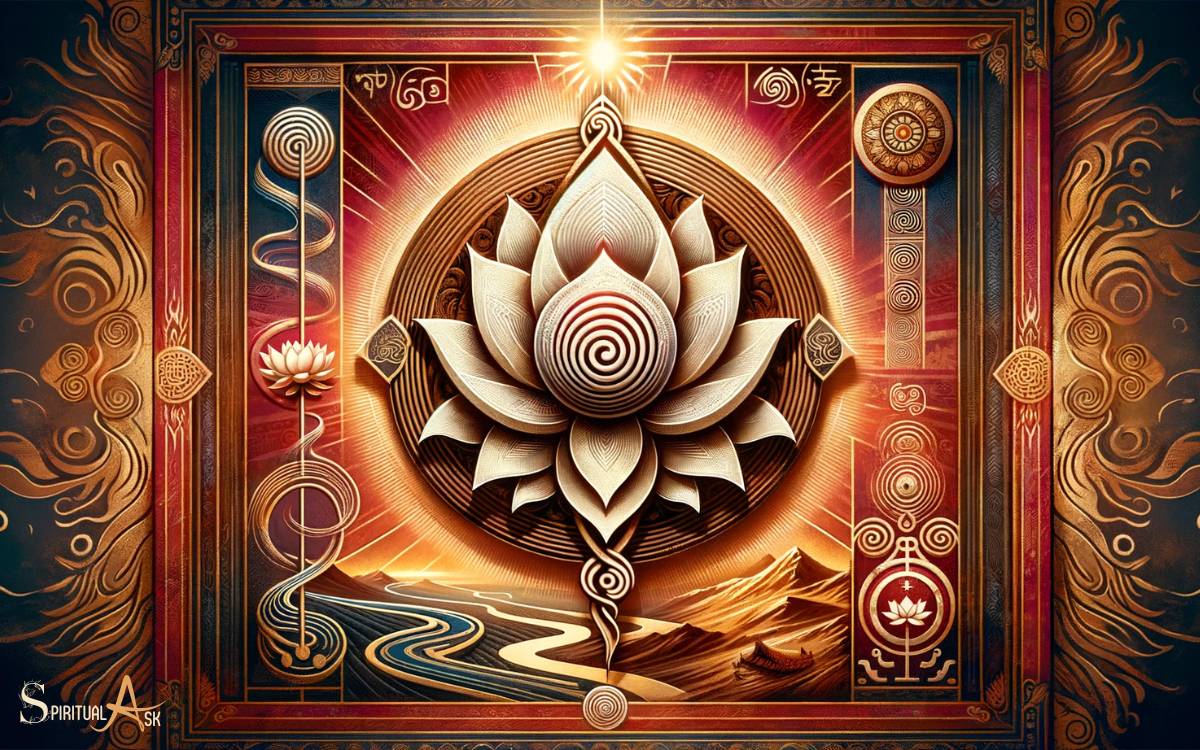Spiritual Symbols Chart Unalome Meaning: Explain!
The Unalome is a spiritual symbol originating from Buddhism, representing the path to enlightenment.
It usually consists of a single line that spirals, twists, and ends in a straight line, symbolizing the journey to finding one’s higher self, overcoming worldly distractions and struggles, and achieving a state of nirvana.
The Unalome symbol often appears in art and tattoos as a visual metaphor for personal development and spiritual growth:
People use the Unalome symbol as a reminder of their growth and as an inspiration to continue their personal journey towards spiritual enlightenment.
Embodying the human quest for purpose, the Unalome serves as a compelling reminder of our progress on the spiritual path, encapsulating the essence of our intricate journey through its elegant design.

Key Takeaway
Origins of the Unalome Symbol

In researching the origins of the Unalome symbol, I found that it has a rich history rooted in Buddhist and Hindu traditions.
The Unalome symbol is a representation of the path to enlightenment in both Buddhist and Hindu cultures.
The spiral stands for the twists and turns in life, and the straight line symbolizes the moment when an individual attains enlightenment or nirvana.
The symbol is often accompanied by a lotus flower, which represents purity, enlightenment, and self-awareness. It’s fascinating to learn how a simple symbol can encapsulate such profound teachings and philosophies.
Understanding the origins of the Unalome symbol provides insight into the deep spiritual and cultural significance it holds for those who embrace its meaning.
Cultural and Religious Significance
Delving into the cultural and religious significance of the Unalome symbol, I find that its profound teachings and philosophies have deeply impacted those who embrace its meaning.

The symbol’s roots in Buddhist and Hindu traditions reveal a complex and meaningful connection to spirituality and self-awareness.
- The Unalome’s representation of life’s twists and turns, and its ultimate path to enlightenment, resonates deeply with Buddhist teachings, emphasizing the journey towards enlightenment as a central aspect of life.
- This symbol also holds significance in Hinduism, where it is associated with the concept of Kundalini, the divine energy believed to be located at the base of the spine, representing the journey of self-realization and spiritual awakening.
These rich cultural and religious connections infuse the Unalome symbol with a depth of meaning that continues to inspire and guide many individuals on their spiritual paths.
Interpretations in Spiritual Practices
I’m excited to explore the symbolic significance of Unalome in yoga and various cultural interpretations. It’s fascinating to see how different cultures have embraced and interpreted this spiritual symbol.

Additionally, I look forward to discussing the modern adoption and relevance of Unalome in today’s spiritual practices.
Symbolic Significance in Yoga
Exploring the symbolic significance of spiritual symbols in yoga has been a profound experience, revealing deeper layers of meaning and insight. In the practice of yoga, these symbols hold rich interpretations that resonate deeply with the spiritual journey.
Lotus Flower
- Represents purity and enlightenment, as it emerges from murky waters unsoiled.
- Symbolizes the journey from darkness to light, mirroring the individual’s path towards spiritual awakening.
Om Symbol
- Embodies the vibration of the universe, encompassing the past, present, and future.
- Signifies the interconnectedness of all beings and the divine energy that flows through everything.
Understanding the symbolic significance of these elements adds a profound dimension to the practice of yoga, enriching the spiritual experience and fostering a deeper connection with the self and the universe.
Cultural Variations and Interpretations
As I delve into the cultural variations and interpretations of spiritual practices, it’s fascinating to see how different traditions imbue spiritual symbols with unique meanings and significance.
| Cultural Variation | Interpretation |
|---|---|
| Hinduism | The Unalome symbol represents the third eye and spiritual awakening. |
| Buddhism | It symbolizes the path to enlightenment, with the twists and turns representing life’s struggles. |
| Thai Tradition | The Unalome is associated with the lotus flower, symbolizing purity and the journey to spiritual fulfillment. |
| Celtic Tradition | It signifies the journey to the center and back out again, representing the cyclical nature of life and rebirth. |
| Native American | The symbol represents the journey of life, with the twists symbolizing the challenges and the straight line depicting harmony and balance. |
Modern Adoption and Relevance
Upon examining the modern adoption and relevance of spiritual symbols, it is evident that their interpretations in contemporary spiritual practices continue to evolve.
As a practitioner, I’ve witnessed how these ancient symbols have found new significance and applications in modern spirituality. Here are some observations:
- Integration into Mindfulness Practices: Spiritual symbols are being used as focal points for meditation and mindfulness exercises, aiding in personal growth and self-discovery.
- Incorporation into Healing Modalities: Many healing modalities, such as Reiki and crystal therapy, incorporate spiritual symbols to enhance their effectiveness and promote holistic well-being.
This dynamic evolution reflects the adaptability and timelessness of these symbols, demonstrating their enduring relevance in today’s spiritual landscape. The spiritual symbolism of infinity is a powerful reminder of the limitless potential and interconnectedness of all things. It serves as a guiding force for individuals seeking to tap into the boundless energy of the universe and connect with their own infinite nature. As society continues to progress, the spiritual symbolism of infinity will undoubtedly continue to inspire and resonate with people from all walks of life.
With this in mind, it’s essential to explore how symbolism and iconography play a pivotal role in understanding spiritual concepts and practices.
Symbolism and Iconography
A common spiritual symbol that I find intriguing is the Unalome, which holds deep meaning and significance in various cultures and traditions.

The Unalome symbol represents the journey to enlightenment in Buddhism and is often depicted as a spiral or a series of twists and turns leading to a straight line.
This symbol is rich in symbolism and iconography, conveying the struggles and triumphs one faces on the path to spiritual awakening.
The spiral is thought to symbolize the twists and turns of life, while the straight line represents enlightenment or the moment of reaching nirvana.
Here’s a visual representation of the Unalome symbol:
| Symbolism | Iconography |
|---|---|
| Journey to enlightenment | Spiral |
| Struggles and triumphs | Twists and turns |
| Path to spiritual awakening | Straight line |
Evolution of the Unalome Symbol
So, let’s talk about the evolution of the Unalome symbol. It’s fascinating to explore the spiritual significance of the Unalome and its cultural origins.

Additionally, understanding how the Unalome has been interpreted in modern times sheds light on its enduring relevance.
Unalome’s Spiritual Significance
The Unalome symbol’s spiritual significance is rooted in its evolution as a representation of the journey towards enlightenment.
As it unfolds, it depicts the struggles and challenges one encounters on the path to spiritual fulfillment.
This symbolism holds deep spiritual significance, as it mirrors the human experience of overcoming obstacles and achieving inner peace.
The Unalome teaches us that the journey to enlightenment is not linear and that each individual’s path is unique. It also symbolizes the idea of finding harmony and balance amidst life’s chaos, guiding us to embrace our imperfections and grow from them.
This spiritual significance resonates with many, as it offers solace and guidance in navigating life’s complexities.
Unalome’s Cultural Origins
Delving into the cultural origins of the Unalome symbol, my exploration uncovers its evolution and the diverse cultural contexts that have shaped its meaning and significance. The Unalome symbol has its roots in ancient Buddhist and Hindu traditions.
- In Buddhist culture, it represents the path towards enlightenment, with the twists and turns symbolizing the struggles and lessons one encounters in life. The symbol is often accompanied by a lotus flower, which signifies purity and spiritual awakening.
- In Hinduism, the Unalome is associated with the third eye chakra and the concept of Kundalini, representing the journey towards spiritual growth and inner peace.
Over time, the Unalome symbol has transcended its original cultural contexts and has been embraced by people from diverse backgrounds seeking spiritual enlightenment and personal development.
Unalome’s Modern Interpretations
Exploring modern interpretations of the Unalome symbol reveals its evolving significance in contemporary spiritual practices.
As spirituality continues to evolve, the Unalome has taken on new meanings and interpretations that resonate with modern seekers.
Incorporation into Tattoos and Jewelry
- Many individuals now choose to adorn themselves with Unalome tattoos or jewelry as a reminder of their spiritual journey and personal growth.
- This modern interpretation reflects a desire to carry spiritual symbols as tangible reminders in everyday life.
Integration into Mindfulness Practices
- The Unalome symbol has found its way into mindfulness practices, serving as a focal point for meditation and a visual representation of the journey towards enlightenment.
- This contemporary use highlights the adaptability of spiritual symbols to meet the needs of today’s seekers, integrating tradition with modern practices.
Embracing the Spiritual Journey
As I embark on my spiritual journey, I am filled with anticipation and curiosity about the path ahead.
The idea of delving deeper into the meaning of spiritual symbols like the Unalome fills me with a sense of purpose and excitement.

Embracing this journey means being open to growth, self-discovery, and transformation. It involves acknowledging that the path won’t always be easy, but understanding that the challenges are essential for spiritual evolution.
I aim to approach this journey with an open heart and mind, ready to learn from the experiences and lessons that come my way.
Embracing the spiritual journey also means accepting that it’s a continuous process, without a fixed endpoint. I’m committed to staying mindful, seeking knowledge, and nurturing my spiritual well-being as I progress along this profound path.
Conclusion
As I reflect on the Unalome symbol and its profound meaning, I am reminded of life’s twists and turns, like the path of the symbol itself.
Just as the Unalome represents the spiritual journey and enlightenment, we too must embrace our own journey, with all its ups and downs, as we strive for inner peace and growth.
The Unalome serves as a beautiful reminder that our paths may be challenging, but ultimately lead to wisdom and understanding.






